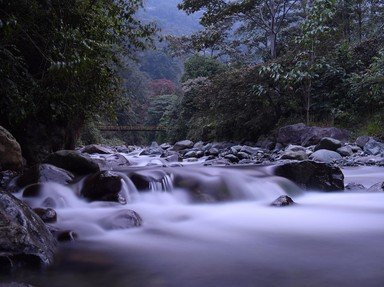Quiz Answer Key and Fun Facts
1. You are very excited to be heading on an expedition to tour the Orinoco River in South America. It might be helpful to know what areas you shall be passing through! What two countries contain the Orinoco River?
2. We decide to start where the Orinoco itself begins. It begins its journey as a series of streams fed by fresh springs in mountains on the border of Brazil and Venezuela. What is this mountain range that is an outlying range of the Guiana Highlands (pictured)?
3. We are now on the Upper Orinoco and heading westward when we pass the small town of Esmerelda. Almost immediately afterward we see the Casiquiare Canal forking off and heading south (as seen in the photo). It is one of the biggest natural river bifurcations in the world. What does that mean?
4. Watch out! We're now in the Middle Orinoco section and we are flowing northward along the border of Colombia and Venezuela. We're in the Region of the Rapids and the water is forcing itself through narrow, stony passages. What are these rocks formed from that also depict art on them from ancient civilizations?
5. The river has turned back to the east and we are floating through the Lower Orinoco now. The river is very wide here and it is slowly crossing over vast plains. We have noticed the incredible amount of flora and fauna and learn from our guide many of them are local just to this area. In particular, one reptile is the largest of its species of its kind in the Americas. What is it?
6. As we continue through the Lower Orinoco we notice we are surrounded by a unique ecological area called a llano. It combines flooded grasslands, foothills, and a savanna. What climate would you say we are experiencing here in the llano?
7. We pass many tributaries joining the Orinoco as we head toward the end of the Lower region. One of the rivers joining us is the Caroni River which in turn leads to the world's highest waterfall. Situated on the Churun River, what is the name of this amazing scene we could visit?
8. We now come out of the Lower Orinoco and come across around 16,800 square miles of land made from sediment that this great river has deposited. Tides bring sea water in to mix with the fresh water from the Orinoco. What is this type of vast area called?
9. As we come toward the end of the Orinoco Delta, we pass several villages of a local people called the Warao. They have lived in this watery area for centuries and even their name means "boat people". They are very friendly and wave to us from their homes. What do these abodes look like?
10. Yes! We celebrate as we are now done and at the end of the Orinoco's long journey. What major body of water did we just feed into?
Source: Author
stephgm67
This quiz was reviewed by FunTrivia editor
Pagiedamon before going online.
Any errors found in FunTrivia content are routinely corrected through our feedback system.
